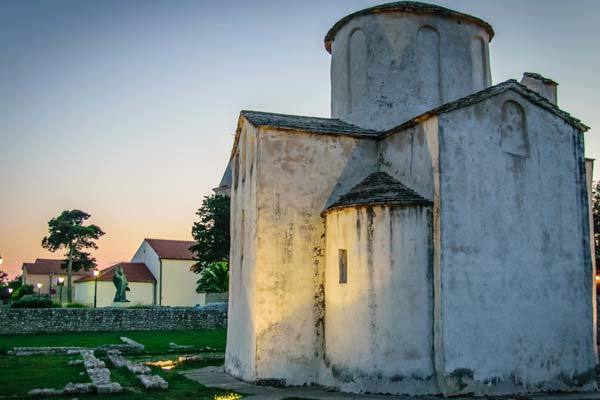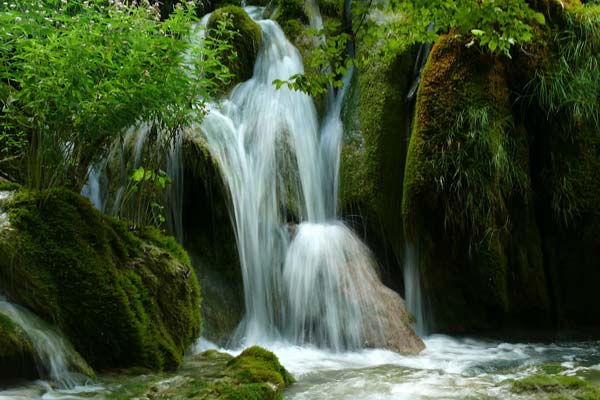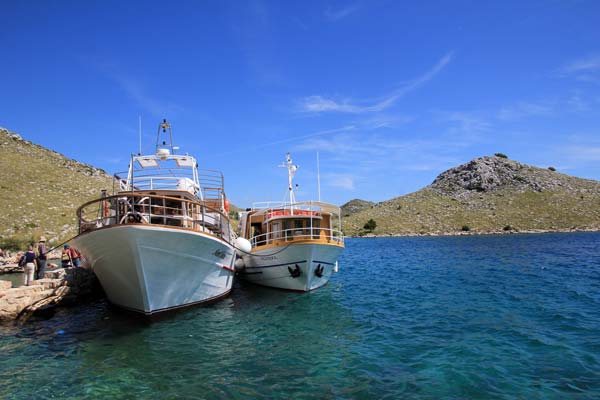HIGHLIGHTS City Attractions
- Sea Organ & Greetings to the Sun
- The Forum
- Tasting of the famous Maraschino liqueur
- People’s sqaure
- Five Wells Square
For two-thirds of its course this virginally pure karstic river, with its seven magical waterfalls and which rises near the town of Knin, flows through canyons. The area is exceptionally rich in endemic flora and fauna, containing 222 types of bird. The watermills along the rivers and above the waterfalls, ruins of fortifications rising above the canyons, the picturesque mouth of the River Čikola above Skradinski buk waterfall – all are specific features of the river landscape. The Krka’s estuary, the 23.5 km-long Lake Pruklja, which reaches up to Skradinski buk is rich in shellfish, freshwater and saltwater fish. Sitting in Lake Visovac, between Roški slap and Skradinski buk (13 km) waterfalls, is a tiny island upon which, set amid a park of sylvan charm, is a Franciscan monastery with a long history. The Krka Monastery (Arhanđelovac) is located in the area of Kistanje, at the point where the canyon widens. The quiet river and lakes are ideal for canoe and kayak tours, but for which it is necessary to obtain a special permit.
HIGHLIGHTS – Official Site
- Skradinski Buk One of the most unusual and most beautiful landscapes of the Krka National Park.
- Roski slap – Especially interesting because of its small cascading falls called „Ogrlica“ -“Necklace”
- Panoramic view of Visovac and Primosten
- Town of Šibenik
- Cathedral of St James
HIGHLIGHTS – Official Site
- Big Waterfall – 78 m high waterfall, the largest in Croatia
- Upper Lakes – a system of 12 lakes separated by travertine barriers.
- Lower Lakes – a system of 4 lakes settled in thr porous limestone canyon.
- Kozjak – largest and deepest lake in the Plitvice National Park.
A national park on the southern side of Velebit, the largest mountain massif in Croatia.
The awe-inspiring torrent gorges of Velika Paklenica and Mala Paklenica which run parallel to each other offer an insight into the unspoilt wilderness that exists not far from the beaches of the Croatian side of the Adriatic Sea, and rank among the most attractive natural areas in the whole of the Mediterranean: dense forests of black pine and beech, watering points for game and delicious springs issuing from beneath the highest peaks of Velebit. Velika Paklenica is a veritable climbers’ Mecca, while cave lovers are drawn by the formidable Manita peć. A rocky trail leads to the entrance into the park, through the gorge to a mountain lodge (6 km). Several other organized shelters are to be found across the mountain. Mala Paklenica, with its dry bed and untamed wilderness of rugged karst and endemic plants and animals, should be negotiated only by experienced hikers.
The most indented archipelago on the Mediterranean, with 140 uninhabited islands, islets and reefs. In the central part of the Croatian Adriatic, on the meeting point of Šibenik and Zadar islands, a separate and by many a specific group of islands, called Kornati, is situated.Because of its exceptional landscape beauty, interesting geomorphology, diversity of the coastline and especially because of the rich biocoenoses of the marine ecosystem, greater part of the Kornati maritime zone has been declared a national park in 1980. Today NP “Kornati” occupies an area of about 220 km2 and it includes 89 islands, islets and cliffs, alltogether with a coastline about 238 km long. Despite this relatively large number of islands the continental part of the park forms only 1 of the total area, while everything else belongs to the marine
Velebit – A mountain system which encompasses two national parks and which in its entirety has been entered into the UNESCO World List of Biosphere Reserves. The most interesting destination among the Croatian mountains for mountaineers, climbers, mountain bikers and which caters for all their eco-adventures.
Croatia’s largest natural lake, situated near Zadar Vransko jezero (Vrana lake) – an ornithological reserve separated from the mainland near Pakoštani by a narrow strip of land. A rich game fishing ground for catfish and carp; also of interest to canoeists and bird watchers.
Because it is one of the rare natural habitats of waterbirds as well as because of its fresh water springs and biodiversity, the Vrana Lake and its surroundings have been declared a nature park on July 21st, 1999. The park’s limits are between Pirovac and Pakoštane. The park stretches across 57 km2, 30,02km2 of that being the lake area itself, which streches in the direction from the North-West to the South-East paralelly to the sea coast, from which it is in some places less than a kilometer apart. The lake is unique for its postition and characteristics not only in Croatia but also in other parts of Europe. It is in fact a karst valley filled with brackish water and is below sea-level
On a small island in the middle of a shallow lagoon the small town of Nin can be found with its old centre, connected to the mainland by two stone bridges. It is the oldest Croatian royal town, the cradle of the Croatian state. The coronation Church of St. Nicholas, can be found here, as well as one of the word’s most beautiful beaches. Tour of the remains of the temple of Diana, Condura (ship from the 11th century), the church of St. Cross, Memorial Gregory of Nin and church of St. Ambrose. Visit the Museum of salt, which dates back to Roman times, with an expert guide, discover interesting stories about salt
Pag is a 60 km long island of North Dalmatia. On its rocky slopes one can find only few blades of aromatic herbs. Due to the lack of greenery characteristic for all the island of Croatian Adriatic, the landscape of Pag is often compared with the Moon surface. The island is inhabited from the Neolithic Era. It is special for its rich cultural inheritance.
The lacework of Pag is listed at UNESCO`s World Intangible Cultural Heritage Register. Women from Pag started knitting it in the 15th century. Pag cheese is known in the entire world as authentic Croatian product. Herds of lambs live on the rocky island slopes and eat aromatic herbs that grow from the karst cracks. Due to the Mediterranean herbs its meat has unique taste. It is especially delicious baked in the embers of fire under the peka bell dome. Besides the lace, salt is the other white gold of Pag island. It always had an important role in the lives of local residents. The production of salt on Pag lasts for more than 1000 years.
- Royal City of Nin
- City of Zadar
- Island Pag
- National Park Plitvice
- National Park Krka
- National Park Kornati





